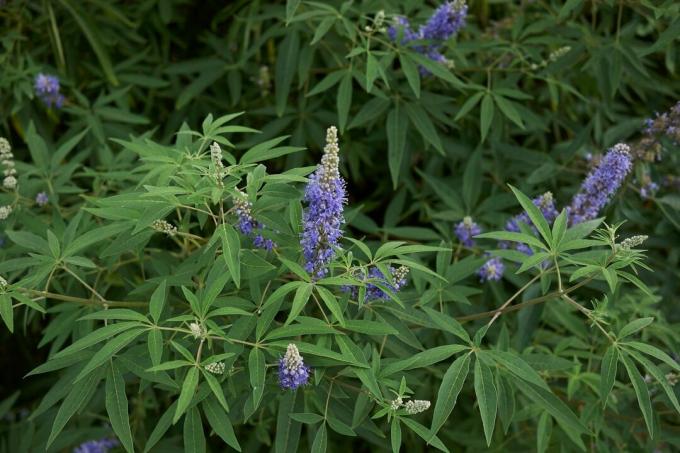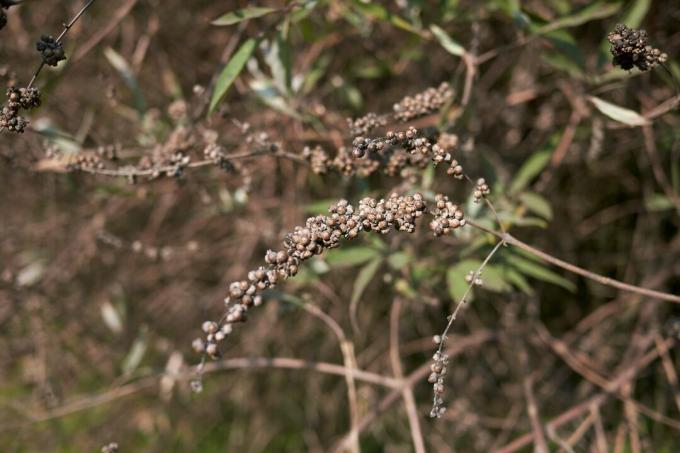The monk's pepper belongs to the mint family and is known for its healing properties. It can also be a real eye-catcher in your garden.

About the medicinal plant Vitex agnus castus, the monk's pepper, in your own garden to bring it to its full glory, of course, certain requirements must be observed. We want to clarify these in the course of this article and also go into the special effects of the plant.
Contents
- Monk's pepper: origin and properties
- The most beautiful chaste tree varieties
-
Planting chaste tree: location, sowing and procedure
- Location
- Sow chaste tree
- Monk's pepper in a pot
- Care of monk's pepper: cutting and Co.
- Is chasteberry hardy?
- propagation
- Harvesting, use and effects of chaste tree
- Is chaste tree poisonous?
Monk's pepper: origin and properties
Colloquially, the monk's pepper (Vitex agnus castus) also called chaste mud or chaste tree, there are also other synonyms, such as Abraham shrub. The plant has its origins in the Mediterranean region - it is now widespread in southern Europe, the Mediterranean region and western Asia. The chaste tree is woody and perennial, so it is a shrub and can reach a height of about three meters. Its leaves are only hairy on the underside and consist of five to seven digits arranged in the shape of a hand. These, in turn, are opposite each other on the grey, felty, four-edged branches of the shrub. The most striking feature is probably the violet-blue flowers of the chaste tree. They sit terminally in cone-shaped flower panicles on the branches and exude a light fragrance. The flowering period extends from July to August. The brown to black, spherical fruits then form, which usually contain four seeds. Botanically, these are stone fruits.

Is chaste tree bee friendly? The plant attracts many insects, including bees, with its fragrant flowers. For them, the chaste tree is an important source of food because, unlike many other plants, it still blooms later in the year.
The most beautiful chaste tree varieties
The different varieties of monk's pepper usually differ in the color of the flowers or the growth height. We introduce you to the most important varieties:
- Vitex agnus castus ‘Alba’: This variety is a white-flowering variant of the monk's pepper. This special feature is evident during the flowering period from August to September. Their growth width and height range from 1 to 3 meters.
- Vitex agnus castus ‘Latifolia’: With its blue-purple flowers that adorn the shrub from July to October, this variety is a real eye-catcher. It can reach a height of 3 meters.
- Vitex agnus castus ‘Blue Diddley’: This small shrub fits into any garden with its compact 1 meter in height and width. It is adorned with blue, fragrant flowers from August to October.
- Vitex agnus castus ‘Pink Pinnacle’: With this variety, the color spectrum is expanded again. It has pink flowers from August to September and is about 2 meters tall and 1.5 meters wide.

Planting chaste tree: location, sowing and procedure
If you want to plant a chasteberry bush in your own garden, there are a few things to consider:
Location
The ideal location for the chaste tree shrub should be sheltered from the wind, warm and in full sun. However, outdoor planting is really only suitable for mild locations - if this is not the case, you should switch to a bucket culture. Even in a wine-growing climate that is warm in winter, the monk's pepper often freezes back and has to sprout again in the spring.
The soil should be permeable and nutrient-rich for the plant. It should be able to store moisture, but not tend to become waterlogged. If the soil for outdoor planting is very humic or loamy, it can be loosened with 30-50% sand, expanded clay or gravel. Very permeable soils can be improved with clay powder or compost. The high nutrient requirement of the chaste tree can be satisfied very well by using compost soil. If you don't have your own compost soil to hand, you can use a high-quality compost-based substrate. In many cases, like ours Plantura organic compost, such a substrate is peat-free. In addition, all of our Plantura soils are certified organic and are made from recycled raw materials.

Organic compost 40 L
- Ideal for all ornamental and useful plants with a high nutrient requirement and for raised beds
- For improved soil quality & healthy root growth
- Peat-free & climate-friendly: CO2-reduced organic soil made in Germany
The shrub thrives best in soil that has a pH in the neutral range of 6.2 to 7.5. If the pH of your soil is in the acidic range, you can raise the pH with a little lime.
A bucket for chaste tree should have a volume of 10 liters or more. When growing in tubs, it is advisable that the filling consists of compost and 30% sand.
Sow chaste tree
- Time: late spring (from mid-March)
- High temperatures for germination: around 22 – 24 °C
- Plant early plants outdoors from mid-May
- Planting distance about 80 - 100 cm
- Sow directly outdoors from mid-May

Monk's pepper in a pot
The chaste tree is suitable for cultivation in a bucket. Especially here in Germany, this variant is preferable due to the temperatures. However, it must be borne in mind that it needs more attention than outdoors, and it should also be kept frost-free but cool in winter to avoid frost damage.

Care of monk's pepper: cutting and Co.
In the field, the monk's pepper is sufficient for an average watering. More can be poured on very warm, sunny days, but it also tolerates dry phases for a few days. However, the soil should not remain dry for longer, considering that the plant naturally prefers to be found in river valleys.
If the shrub is in nutrient-rich soil, additional fertilizer is hardly necessary. In spring, if necessary, the soil can be enriched with small doses of organic fertilizer or compost. When caring for potted plants, it is important to ensure regular watering and an adequate supply of nutrients. Our Plantura organic flower fertilizer is particularly suitable for the supply of potted plants and also increases resistance to pests, drought and frost thanks to a rich supply of potassium.

Organic flower fertilizer 1.5 kg
- Ideal for flowering plants in the garden and on the balcony
- For strengthened plants with a magnificent, long-lasting bloom
- Animal-free organic slow-release fertilizer - safe for pets and garden animals
To promote the willingness to flower, the shrub can be cut back vigorously in spring and frozen shoots removed.
Is chasteberry hardy?
The perennial shrub is only partially hardy, so it can survive short periods of frost, should, however, be well protected in winter or taken to winter quarters if planted in tubs is.
In the field, the plant can be given additional protection by mulching the root disk or wrapping it in bast mats. Fir branches, which are inserted between the shoots close to the ground, are also suitable for this.
The potted plants should be overwintered cool, just frost-free. Overwintering indoors is unsuitable, because the warm temperatures can upset the growth rhythm of the plant and disrupt budding.
propagation
If you want to propagate your chaste tree, there are two options. From October, the seeds of the shrub can be collected and then dried well. The sowing then proceeds as already explained above. In the other method, green or half-ripe cuttings are cut from the plant in summer, defoliated below and either in a glass of water or directly in the moist soil at warm temperatures rooted.

Harvesting, use and effects of chaste tree
The ripe fruits are harvested Vitex agnus castus after flowering. Extracts of the fruit are used in the manufacture of ready-to-use preparations. In naturopathy, the chaste tree is mainly used for menopausal symptoms, endometritis, menstrual problems and some other diseases. It has been scientifically proven that the fruits of the plant can balance female hormone levels. The reason for this is the inhibition of prolactin release. Overall, the effect of chaste tree, in contrast to many other medicinal plants, has been researched fairly well.
The self-harvested seeds can be prepared as tea, for example, or used as a pepper-like spice in the kitchen. However, you should find out in advance about the dosage or possible side effects or interactions. It is safest to purchase the chaste tree for ingestion with appropriate clarification in the pharmacy.

Is chaste tree poisonous?
Vitex agnus castus is slightly toxic - like many other medicinal plants. But the dosage plays the essential role here, because small or recommended amounts are harmless when used. Monk's pepper can even be used on dogs, but it can also be used on cats or children under the age of 18 and it should not be used by pregnant and breastfeeding women unless this has been discussed with the doctor became.
Another important medicinal plant for women is the evening primrose (Oenothera), which is also a good food source for butterflies. We present the most beautiful types of evening primrose and give tips on cultivation and use.
Register now for the Garten-Post and receive great tips, seasonal trends and inspiration on everything to do with the garden from our expert every week.


